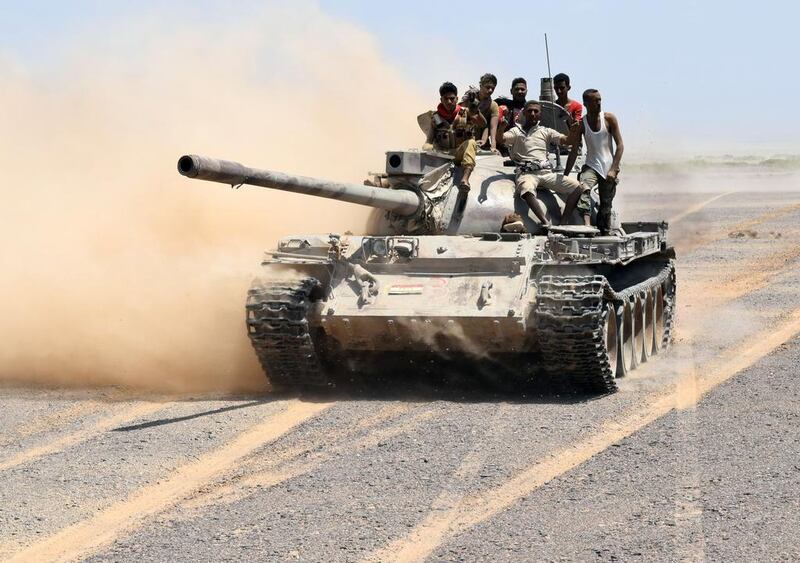ADEN // Taez has become the new front line in Yemen’s war against the Houthis as pro-government forces move across the province to capture its capital of the same name, which has been ravaged by months of fighting and the spread of disease.
Fighting along Yemen’s Red Sea coast intensified after loyalist forces of president Abdrabu Mansur Hadi – backed by coalition forces from the UAE and Saudi Arabia – last Thursday helped the resistance in Taez regain control of areas leading to the Bab Al Mandeb strait, along with Mayoun island, situated in the waterway itself.
Bab Al Mandeb is strategically important – about 20 per cent of all trade and almost 7 per cent of oil and fuel cargoes pass through the narrow waterway, located on Yemen’s southwestern coast.
Winning control of these areas was the first step towards driving the Houthis out of Taez, said the spokesperson for the province’s popular resistance, Rashad Al Sharabi.
"The forces will start the war from Bab Al Mandeb, and then they will go towards Mokha district and finally they will reach the entire province," he told The National.
The UAE Foreign Minister, Sheikh Abdullah bin Zayed, said the recapture of areas around Bab Al Mandeb was a military victory.
“We consider the complete control taken by coalition and popular resistance forces over the Bab Al Mandeb and the defeat of the Houthis as the beginning of the end of this renegade group and those backing them,” he said in a speech before the United Nations on Friday.
The city of Taez, about 330 kilometres south of Sanaa, is widely seen as a crucial gateway to recapturing the capital from the Houthis.
Yemen’s third largest city has been resisting a Houthi takeover for six months.
When Mr Hadi fled Sanaa in March, the Iran-backed rebels chased him towards the southern port city of Aden, cutting across Taez.
But the popular resistance there – made up of Yemeni army soldiers loyal to Mr Hadi, and tribal forces fighting to protect their territorial turf – tried to repel the Houthis, preventing them from passing through or entering the city.
Since then, skirmishes between the two sides have continued and the Houthis have not been able to take full control of Taez’s capital. The rebels currently control only pockets of the city – such as Al Hawban and some other areas, while the popular resistance holds most of the province.
The Houthis did, however, manage to take over several significant areas of Taez province, including the main road that connects Taez with Ibb province in March, and Mayoun island and areas leading to Bab Al Mandeb in April.
Houthi spokesperson Mohammed Abdulsalam claimed that the rebels withdrew from areas around Bab Al Mandeb on Thursday to avoid an all-out war along the strait as conflict in the waterway would affect international interest.
The Al Wazeya district in Taez has been the focal point of the battle since the Houthis lost Bab Al Mandeb on Thursday.
The district is of key importance to the coalition as it connects Taez to Lahj and Aden, and will be needed to bring in military reinforcements. Hundreds of people have fled Al Wazeya towards rural areas since fighting intensified.
According to a report released last week by the Office of the United Nations High Commissioner for Human Rights (OHCHR), the civilian death toll from the war in Yemen has reached at least 2,355. Another 4,862 civilians have been injured.
Despite coalition air strikes pounding Houthi targets in Taez, resistance forces have not been able to dislodge the Houthis from the province.
Victory is not expected to be easy as the rebels likely pulled their forces back to Taez city following recent victories by pro-government forces in Yemen’s south. Adding to the complexities, hundreds of Houthi rebels who originated from Taez are also fighting pro-government forces across the province.
A Houthi sympathiser, originally from Taez, spoke with The National on condition of anonymity, claiming that the Houthis were fighting to purge members of Al Qaeda in the Arabian Peninsula (Aqap) who were killing civilians in Taez.
Amid the war, residents in Taez are also fleeing the deadly spread of dengue fever in Taez, seeking safer havens in rural areas.
The World Health Organization warned in August of an “extreme spike” in the number of dengue cases in Taez, which nearly tripled from 145 in mid-August to 421 during a two-week period.
From March to September, more than 1,600 cases of dengue fever were reported in Taez province, according to the United Nations.
“Limited accesses to health care services, a breakdown in safe water supply and sanitation services as well as accumulation of garbage have facilitated the spread of dengue fever in the governorate,” said Dr Ahmed Shadoul, WHO Representative for Yemen last month.
“Moreover, scarcity of water has forced people to collect rainwater in plastic containers, resulting in the spread of the yellow fever mosquito [Aedes aegypti] in these containers.”
Aid organisations also face tremendous difficulties reaching Taez due to the ongoing clashes.
Humanitarian access to the province remains a major challenge to aid agencies as most of the roads to Taez have become inaccessible, added Dr Shadoul.
foreign.desk@thenational.ae
* Additional reporting from Bloomberg and Reuters





